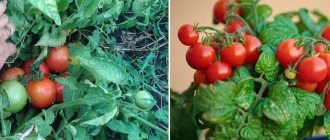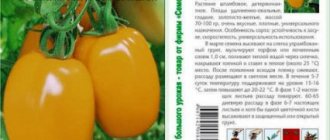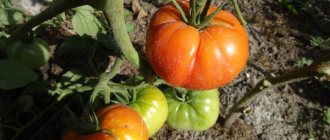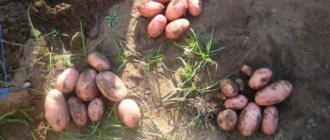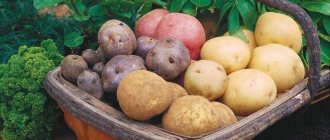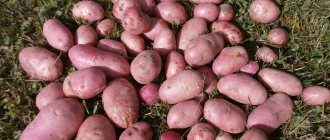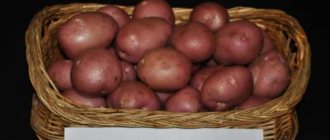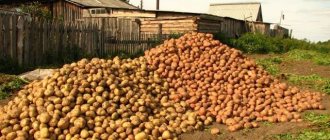The best potato varieties for Siberia
Of the more than four hundred varieties of potatoes grown in Russia, only a small part is suitable for the agricultural industry and private farming of Siberian gardeners. The reason that not all the best potato varieties for Siberia become productive is the peculiarities of the Siberian climate with its short summer, late spring and too early autumn frosts.
The best potato varieties for Siberia
Growing potatoes in Siberia
Siberian climatic conditions dictate to gardeners their requirements for the vegetable varieties they select for planting. Among the basic rules for selecting seed material for growing potatoes in Siberia, the resistance of vegetables to the cold Siberian climate and possible sudden changes in temperature is noted.
It is recommended to choose potatoes for Siberia based on the location of the planting site. Thus, vegetable crops successfully grown in the western Siberian regions are not suitable for planting in the eastern part.
The best time to grow potato crops in Siberia is from May to August. If the description of a potato crop with frost-resistant quality characteristics covers this period, the vegetable crop is quite suitable for growing in the harsh Siberian climate both in the west and in its eastern part.
What is suitable for western regions
The most popular potato varieties for the west of the Siberian region are those that are early ripening and have medium ripening periods. Such species can be planted in the first half of May: the seeds have time to ripen and produce a harvest.
What is suitable for the eastern regions
Gardeners choose new varietal types of potatoes for cultivation in the east more carefully than summer residents of Western Siberian regions. The reason for this selection is the not particularly good climate for planting and care:
- early arrival of winter frosts,
- uneven precipitation in large quantities,
- The redistribution of precipitation is greater at the end of the summer season or at the onset of September.
For these regions, it is imperative to choose frost-resistant types of potatoes, which are described as early ripening.
Planting potatoes in Siberia, timing
The capricious climate of Siberia dictates the timing of potato planting. In Western Siberia, with a milder climate, planting most often begins in early May. Eastern Siberia is characterized by longer winters and returning spring frosts, and therefore potato planting begins here later, around mid-May. Some gardeners, guided by folk superstitions, associate the beginning of planting with the opening of buds on birch trees. Fortunately, potatoes have a fairly long period from planting to the first shoots. The danger of destroying seedlings by frost is not as high as the risk of planting tubers in frozen, immature soil. The soil is ready for planting if it has warmed up to 6–7°C at a depth of at least ten centimeters. At lower temperatures, only sprouted tubers are planted. Mature soil is not lumpy and crumbles, providing germinating roots with sufficient oxygen.
Early varieties
Early varietal potato lines are most in demand in the Siberian regions, as they guarantee that the potato crop will have time to ripen on a personal plot.
Ural early
This good early-ripening table variety of potato is suitable for the Siberian region due to its rapid ripening and resistance to various diseases of vegetable crops.
Priekulsky
Called “forty days” by Siberians, the Priekulsky potato variety is an excellent choice for planting in Siberia. As the name implies, you can get a harvest from a good Priekul vegetable after 40 days. Early ripening potatoes manage to ripen before numerous diseases begin to affect potato bushes and root crops.
According to the description, the fruits of the Priekul species are white, oval, weighing up to 100 g. Yields are average - up to 250 kg per 1 sq. m of sown area.
Variety Udacha pleases with early harvest
A potato variety for Siberia called Udacha is not afraid of pests or diseases, easily tolerates arid climates and copes with prolonged rains. It has an early ripening period - 45 days.
Round-oval vegetables weigh 150-300 g, have white flesh and peel. Potatoes Udacha can reach a yield of 300 kg per garden hectare.
Potatoes for Siberia: the best early varieties, which ones to choose, how to germinate
Siberia is considered a harsh region in which little will grow. But that's not true. The whole point is that it is necessary to select plant varieties that are adapted to difficult climatic conditions. This article will discuss which potato varieties are most suitable for growing in the Siberian region.
Description of culture
Potato is a perennial tuberous plant of the Solanaceae family. The number of shoots in the bush varies, depending on the variety and care, from 4 to 10. The leaves are dark green, located on short petioles. The flowers are small, usually white, but also pink and purple.
The outer part of the tuber consists of cork tissue. Along the entire surface there are depressions called eyes. New plants develop from them. From a tuber immersed in the ground, shoots diverge, reaching a height of up to 0.5 m.
Depending on the variety, the potato skin can be in color: yellow, pink, purple, brown. Tubers also differ in shape, weight, color and taste of the pulp.
Potato varieties for Siberia
Dutch potato varieties
Siberia occupies 57% of the territory of Russia. Its climate is continental. The summer weather in Gorno-Altaisk, for example, can vary from 9 to 40°C. The Altai Range protects Siberia from the cold Kazakh winds, and the Vasyugan swamps smooth out temperature changes. Despite the harsh climate, more than 50 varieties of potatoes are allowed to be planted in this region.
Note! In order for the potatoes to have time to fully form, the variety must be selected early, mid-early or mid-ripening, since later varieties may not have time to ripen.
Tubers planted in Siberia must develop well, be productive, resistant to lack of moisture, temperature changes, and resistant to pathogens.
Let's consider which potato varieties are the best for Siberia.
Alyona
These are early ripening potatoes of domestic selection. It ripens within 70-75 days from the moment the shoots appear. The bushes are spreading, the tubers are medium-sized, weighing up to 150 g. Their surface is smooth, red, with the presence of small eyes.
The starch content of the tubers is 15-17%, so they are suitable for frying and preparing salads. Alena potatoes are resistant to drought and many diseases. May be susceptible to nematodes and late blight.
Adretta
Potatoes were bred by Western breeders. She is of medium maturity. The harvest is harvested 2-2.5 months after the first shoots appear. The color of the tubers is yellow, their starch content is about 18%. They have good taste and keeping quality. Adretta makes delicious potato chips.
Potatoes are resistant to cancer and viruses, and susceptible to late blight and scab, but with proper care they can be prevented. Adretta can withstand both some drought and excessive moisture.
Zhukovsky early
This is another variety adapted for harsh climates. The name of this variety of domestic selection speaks for itself. He is precocious. Early Zhukovsky can be removed from the ground 2 months after germination.
Root vegetables are small in size, pink on the outside, white on the inside. They contain about 12% starch and are used mainly for frying, preparing salads and soups. The skin of the tubers is dense, due to this they are well stored. Zhukovsky early can be affected by late blight. Prevention and crop rotation will prevent this disease.
Potatoes Zhukovsky early
Lugovskoy
This variety of potato was bred by Ukrainian breeders. It is unpretentious, therefore it is widespread not only in Siberia and Altai, but also in other regions of Russia. The first harvest is harvested after 2.5 months, full ripening - after 3.
The weight of the tubers is small, up to 125 g, and the shape is oval. The pulp is white, the peel is light pink. Tubers contain about 19% starch. This variety is resistant to cancer; resistance to other diseases is average.
Lyubava
The variety was bred by domestic breeders specifically for the Urals, Siberia, and the Far East. Potatoes ripen within 2-2.5 months, forming tubers. The fruits are medium or medium-sized, weighing up to 210 g and starch content of about 17%.
Lyubava has excellent taste, good shelf life and transportation. Varietal potatoes are resistant to cancer, but can be affected by nematodes and late blight.
Preparing potatoes for planting in Siberia
When to get potatoes for germination in Siberia, the weather will tell you. Potatoes begin to be prepared 30-35 days before planting in open ground. It needs to be taken out of the basement and placed in a warm place to germinate. It is advisable to disinfect the tubers in a solution of potassium permanganate or garlic.
The germination process is important for the reason that in Siberian conditions, seedlings must sprout quickly in order to have time to fully ripen. Therefore, the planting material must have sprouts with root rudiments.
Important! Seed material must be healthy to prevent the spread of diseases.
Planting process
Early potato varieties for the Moscow region
In Siberian conditions, potatoes are planted in 3 ways:
- One-liner. With this method, the tubers need to be planted in rows at a depth of 7 cm with an interval of 25 cm from each other. The distance between the rows is 60-70 cm.
- Tape. With this method, the sprouted tubers are planted in 2 strips, the distance between which is 30 cm. The next 2 furrows are dug every 110 cm. Potatoes are grown using this method on an industrial scale.
- Comb. With this method, potatoes are planted at a shallow depth and covered with earth (ridge) to a height of 20 cm. With this planting, potatoes have good germination and the harvest is harvested 2 weeks earlier.
They begin to plant potatoes after the soil has been well warmed by the sun.
Planting potatoes in Siberia
Potato care
The first watering is carried out after the seedlings begin to germinate. It is recommended to perform the procedure in the evening, under each bush, pouring about 7 liters of water. During the dry season, potatoes are watered up to 5 times.
When the soil dries out a little, it needs to be loosened. The procedure will increase oxygen access to the roots, and therefore help the tubers germinate. In addition, weeding will destroy growing weeds, and you won’t have to pull them out manually later.
Note! Until the shoots appear on the surface, you cannot loosen the ground and weed the weeds, as the seedlings may be damaged.
In Siberia, even in June there is still a high probability of frost, so the bushes need to be hilled[/alert. You can put mulch under them from mown grass, straw, sawdust, and last year's leaves.
High-yielding varieties
Many high-yielding potato varietal lines make it possible to grow a large and good harvest even in unfavorable regional Siberian conditions.
Early ripening potatoes Alena are loved by Siberian gardeners for their high yield, reaching 300 kg per 1 sq. m of sown area. The tubers, which ripen on average in 2-2.5 months, weigh 100-100 g, have an oval shape, pink skin and white flesh.
Related article: Potato varieties for the Central Black Earth region: list
These productive potatoes have good shelf life, reaching 95%, and retain a pleasant appearance during transportation.
Resistant to scab and potato cancer, Alena is often exposed to late blight. It is suitable for cultivation throughout the Siberian region, as it is frost-resistant.
Showing a yield of about 300 kg per hundred square meters, the early-ripening table potato variety Antonina is able to resist late blight and powdery mildew.
The vegetable is distinguished by a yellow, slightly rough peel and dark yellow flesh. Gardeners note good shelf life: the harvest is preserved in 95% of cases.
Most often, Antonina can be seen in summer cottages in the western part of Siberia.
A universal variety that has proven itself among gardeners due to its increased yield. Some summer residents collect 350-360 kg per square meter. m of sown area. Potato tubers with white flesh weigh on average 110-130 g, and there are up to 15 vegetables in the nest. This variety is suitable for western and eastern Siberia.
Ermak is included in the list of the best potato varieties in Siberia in terms of yield, producing up to 500 kg with an average weight of potato tubers of 100 g. A potato nest has up to 25 root crops. Round-shaped vegetables with pink smooth skin and light flesh.
Ermak is recommended for cultivation in any Siberian region.
What kind of potatoes can be grown in Siberia and the Urals
Properly selected varieties depending on the climate of the region guarantee productive beds. Knowing the features of time-tested potatoes and analyzing reviews of new products, you are less likely to get into trouble with the harvest. I would like to highlight those varieties that differ significantly in their performance from other more well-known ones.
Potato varieties with a short growing season
Charoite is a new forty-day variety, the first harvest of which can be obtained already on the 40–45th day. Return - up to 380 c/ha. Potatoes with heavy tubers (up to 140 g), smooth light skin and a yellowish center contain 17% starch; when cooked, the flesh remains tender and does not crumble. The variety is susceptible to nematodes, but rarely suffers from late blight.
Early ripening Charoite allows gardeners to experiment and get two harvests per season
Meteor is an ultra-early variety that has been pleasing gardeners for more than 10 years. The growing season is 45 days. The skin is ocher, rough; the flesh is rich yellow. Unlike Charoite, it has a higher yield - almost 450 c/ha (up to 6 kg per bush). The mass of tubers of these varieties is the same, but Meteor is 3% inferior in starchiness - you can bake it “in their uniform” and put it in salads. They love him for his endurance - he rarely gets sick and keeps up well.
Meteor's tubers are not large, but there are more than 10 of them in a bush
In comparison with other early varieties for the northern regions and the Urals, Karatop has an amazing yield - up to 500 c/ha. Viral diseases bypass this variety; potatoes are stored until spring. Tubers (100 g or more) with yellow skin and the same pulp contain no more than 14% starch - a classic potato for first and second courses.
Early Karatop is perfect for the unstable Siberian climate
Bashkir is an early ripening variety cultivated in the Ural region. It has a high yield - more than 480 c/ha. Large pink-sided tubers with yellowish flesh weigh on average almost 200 g. The cultivar with a high starch content (about 20%) has good shelf life. Bashkirsky’s immunity is not very resistant to viruses and diseases.
Bashkir was bred more than 10 years ago specifically for cultivation in the Urals
Mid-season potatoes
In Memory of Rogachev, record yield figures for mid-season varieties are 522 c/ha. Rough pale yellow tubers with light flesh (starch content more than 20%) gain almost 160 g. Potatoes do not suffer from cancer and scab; if stored properly, they last until mid-spring.
The Memory Rogachev variety is quite starchy, it will be appreciated by those who love boiled and baked potatoes
The weight of Lazar potato tubers is the same as that of the previous variety, and the amount of starch exceeds 23%. These potatoes are good to put in casseroles and make mashed potatoes from them. On average, one bush produces up to 4.5 kg of red-pink tubers with snow-white pulp. The cultivar is susceptible to nematodes, but is rarely affected by late blight and leaf curl.
Pink-fruited Lazarus, according to reviews from summer residents, is very aromatic and tasty
The Zlatka potato received its name for its bright yellow tubers with beige pulp (18% starch). On average, ripe tubers weigh 120–160 g. The variety has an excellent yield for the Siberian climate - 460 c/ha, and is highly resistant to many diseases.
Zlatka potatoes are highly marketable
Many summer residents living beyond the Urals choose the Irbitsky variety: the tubers are light-colored, large - 160-180 g each, with a red smooth skin and a starch content of approximately 16.5%. This potato is not afraid of nematodes, cancer, and striped mosaic. The variety fits well in the vegetable storehouse and bears fruit abundantly (yield - 468 c/ha).
Irbitsky has large oval tubers with rough skin
Late potato varieties for the Urals and Siberia
Lugovskaya has been known for almost half a century; thanks to its good taste and high yield (more than 500 c/ha), this variety has become the leader among late varieties in the Urals and Siberia. Potatoes have oval tubers with pinkish smooth skin (weight 125 g) and white pulp with a low starch content of 12%. It was ranked among the first for its high immunity to late blight, blackleg and scab. Potatoes with late ripening
Lugovskaya has been cultivated for many years in most regions of our country.
Mustang is recognized as the best late-ripening variety in Eastern Siberia. The cultivar with oval, ruddy fruits (100–150 g each) and appetizing yellow pulp contains about 19% starch; when cooked, the pulp becomes loose, but does not soften. Productivity is within 380 c/ha, the variety is resistant to wrinkled mosaic and cancer.
Pink Mustang tubers hardly crack when baked
White-fruited Nikulinsky is loved for its yield (more than 400 c/ha) compared to other varieties with a long growing season. The advantage of the variety is 21% starch. The weight of the tubers ranges from 70 to 135 g. Nikulinsky is good both boiled and stewed, and for baking. The variety is perfectly stored until summer and is slightly susceptible to viral diseases.
Snow-white Nikulinsky pulp does not darken when cut
For the Urals, according to reviews of local gardeners, among the late varieties it is impossible to find better than Belousovsky. The round, whitish tubers with the light flesh typical of potatoes are not large (about 90 g), but the yield of one bush reaches 6 kg. Potatoes contain up to 19% starch. The variety tolerates drought well and is rarely affected by late blight.
Belousovsky potatoes ripen later than others and are stored until the end of spring
Table: other potato varieties for the Ural region and Siberia
Video: characteristics of some potato varieties suitable for cultivation in Siberia and the Urals
It is difficult to choose one potato variety once and for all; on different soils and in different years, this crop behaves differently. Definitely, varieties for Siberia and the Urals are distinguished by strong immunity and rarely suffer from seasonal disasters, which is why they have become famous in many regions of Russia. Siberians have learned to obtain enviable harvests in any weather conditions: potatoes are grown in warm beds, in bags, under straw, in trenches (without resorting to hilling).
Frost and disease resistant varieties
For cultivation in Siberia, the resistance of vegetable crops to pests and plant diseases is of great importance. In Siberia, not the least place in the characteristics of potato subspecies is occupied by the frost resistance of the variety.
This is the most suitable potato variety for the western Siberian regions, although it is also successfully grown in the east. This is a Dutch variety with oval tubers and light skin, resistant to scab and late blight. Yields reach 2.0-2.5 kg per potato bush.
Freske, bred by Dutch selection, shows resistance to the main diseases of vegetables: nematode and late blight. It tolerates changeable climatic conditions well, which is why it is on the list of the best varieties for Siberia. Potato tubers have a smooth surface and yellow skin.
Prior is a universal variety from the same Dutch selection. Often up to 1.0-1.2 kg of potatoes are harvested from a bush.
The variety is resistant to nematodes, powdery mildew and late blight. The oval root vegetables have a slightly elongated shape and a cream-colored peel, strewn with small purple eyes.
One of the best potato varieties for Siberia in terms of resistance to harsh climates is Adretta. This species is able to withstand sudden changes in weather, is resistant to diseases and is slightly susceptible to damage by pests. For these characteristics, many summer residents fell in love with it, despite the low yield: only 170-200 kg per 1 sq. m. Its tubers grow weighing up to 100-140 g, with white skin and yellowish pulp.
Varieties for growing in Siberia
The level and stability of the yield in such harsh conditions is largely determined by the characteristics of the variety . All varieties recommended for cultivation in Siberia are immune to the causative agent of potato canker.
Zhukovsky early, Latona, Khozyayushka, Rosara, Fresco, Sarovsky, Bravo, Zekura, Irbitsky, Rozhdestvensky, Ryabinushka, Aramis, Madeline, Felox are resistant to the golden nematode.
Early
The main characteristics of early varieties that can withstand the Siberian climate are presented in the table:
| Variety | Origin, year of inclusion in the State Register of the Russian Federation | Ripening time, days | Tuber coloring | Mass of tubers, g | Productivity, c/ha | Starch content, % | Disease resistance |
| Alyona | Russia, 2000 | 45–55 | Red | 86–167 | 172–292 | 15–17 | Immunity to scab, rhizoctonia. Susceptible to late blight. |
| Antonina | Russia, 2005 | 60 | Yellow | 104–153 | 211–300 | 16–20 | Moderate susceptibility to late blight. |
| Zhukovsky early | Russia, 1993 | 60–90 | Pink | 100–120 | 400–450 | 10–12 | Susceptibility to late blight. |
| Priekulsky early | Latvia | 70–75 | White | 100–120 | 200–280 | 13–15 | Susceptibility to late blight, scab, viral diseases. |
| Luck | Russia, 1994 | 45–60 | St. beige | 120–250 | 300–500 | 12–15 | Susceptibility to late blight. |
| Ural early | Russia, 1977 | 60–70 | White | 100–140 | 300–380 | 12–15 | Average susceptibility to late blight. |
Mid-season
Features of mid-season varieties:
| Variety | Origin, year of inclusion in the State Register of the Russian Federation | Ripening time, days | Tuber coloring | Mass of tubers, g | Productivity, c/ha | Starch content, % | Resistance to diseases and pests |
| Adretta | Germany, 1980 | 60–80 | Yellow | 100–150 | 240–400 | 13–18 | Relative resistance to viruses, susceptibility to late blight, scab, rhizoctonia. |
| Lina | Russia, 1998 | 75–85 | Yellow | 105–250 | 213–496 | 11–19 | Susceptible to nematodes, resistant to late blight. |
| Lugovskoy | Ukraine, 1987 | 80–90 | Holy pink | 85–125 | 300–510 | 12–19 | Insufficient immunity to late blight, scab, blackleg, viruses. |
| Nevsky | Russia, 1982 | 70–85 | St. beige | 90–130 | 380–500 | 10–12 | Moderate susceptibility to late blight. |
| Svitanok Kyiv | Ukraine, 1987 | 85–105 | St. red-violet | 100–170 | 350–450 | 16–19 | Immunity to black scab, average resistance to blackleg, viruses, susceptibility to late blight. |
| Mistress | Russia, 2009 | 80–100 | Red | 101–179 | 178–355 | 17–22 | Resistance to cancer, nematode. |
Universal
Valuable traits of universal varieties:
| Variety | Origin, year of inclusion in the State Register of the Russian Federation | Ripening time, days | Tuber coloring | Mass of tubers, g | Productivity, c/ha | Starch content, % | Disease resistance |
| Latona | Netherlands, 1996 | 65–80 | Yellow | 85–135 | 291–300 | 12–16 | Average immunity to viruses, dry and ring rot, weak - to scab, late blight. |
| Rosara | Germany, 1996 | 60–70 | Red | 80–115 | 202–310 | 12–16 | Slight susceptibility to late blight and scab. |
| Timo Hankkiyan | Finland, 1999 | 50 | Yellow | 65–120 | 150–233 | 13–14 | Susceptibility to late blight, viruses. |
| Fresco | Netherlands, 1994 | 60–70 | Yellow | 100–130 | 200–390 | 12–17 | Average resistance to viruses, scab, rhizoctonia, weak resistance to late blight. |
Potato tubers contain 22–25% dry matter, including:
- starch - 70–80%;
- protein with essential amino acids - 2-3%;
- fiber - 1%;
- fats - 0.2-0.3%;
- mineral salts of calcium, iron, magnesium, sulfur, iodine - 1%;
- vitamins C, A, PP, K, group B.
The daily requirement for vitamin C is provided by a serving of boiled potatoes weighing 300 g , and essential amino acids - 600 g.
For Western Siberia
This is a more favorable region for culture : summer temperatures here reach +20°C and above.
Sarovsky
The variety of domestic selection is most adapted to the weather conditions of the region . In 60–70 days it produces 112–247 c/ha.
The average weight of red round-oval tubers is 95–150 g . The yellow pulp contains 14–18% starch and does not darken when cooked. Keeping quality of potatoes is 96%. The variety is resistant to cancer and golden potato nematode, wrinkled mosaic and leaf curl, and is susceptible to late blight.
Baron
An early ripening variety was created at the Ural Research Institute of Agriculture and included in the State Register in 2006 . Marketable yield is 113–237 c/ha. Yellow tubers weighing 110–190 g with white pulp and good taste contain 13–15% starch. Baron is susceptible to late blight and is affected by scab.
Potato Baron
Zekura
The mid-early variety Zekura of German origin is less susceptible to common scab, late blight and severe forms of viral diseases. Vegetables ripen in 90–100 days . Oblong yellow tubers weighing 60–150 g contain 13–18% starch. Productivity - 195–323 c/ha.
Potato Zekura
Irbitsky
The mid-season Irbitsky was bred at the Ural Research Institute of Agriculture and entered into the State Register in 2012 . It is characterized by high yield, up to 400 c/ha, immunity to wrinkled and striped mosaic, leaf curl virus. The mass of red-skinned tubers is 108–185 g, starchy content is 13–17%.
Potatoes Irbitsky
Kamensky
An early culture created on the basis of the Ural Research Institute of Agriculture, entered into the State Register of the Russian Federation in 2009 . The variety is resistant to wrinkled and striped mosaics, leaf curling, and is susceptible to late blight and nematode. The skin is red, the flesh is light yellow. Tuber weight: 95–110 g. Starch content: 12–17%. Marketable yield - 185 c/ha.
Potatoes Kamensky
Christmas
The mid-early variety was created by the Leningrad Research Institute of Agriculture and was included in the register of approved varieties in 1993 . Rozhdestvensky is immune to potato nematode, moderately resistant to the viral diseases late blight and fusarium. The skin of the tubers is light beige, the flesh is creamy with a starch content of 14–16%. Vegetable weight - 95 g, yield - 330–430 c/ha.
Rowanushka
It was bred on the basis of the Vsevolozhsk Breeding Station and was included in the State Register in 2007 . Productivity - 220–234 c/ha. The maximum figure (396 c/ha) was obtained in the Moscow region. The tubers are oval with small eyes, smooth red skin, weighing 90–135 g. The creamy pulp contains up to 15% starch. The variety is resistant to cancer and nematode, susceptible to late blight.
Potatoes Rowanushka
For Eastern Siberia
The crops for this region are more cold-resistant and still produce a rich harvest.
Aramis
This mid-season table variety was created by scientists from the Krasnoyarsk State Agrarian University together with the All-Russian Research Institute of Potato Farming named after. A. G. Lorkha. Productivity is 166–250 c/ha. The color of the vegetables is yellow, weight - 100-156 g, starch content - 14-16%. Aramis is resistant to striped mosaic, leaf curl, and is susceptible to late blight.
Borus 2
It was developed at the Research Institute of Agrarian Problems of Khakassia, and in 2005 it was included in the State Register . Red tubers with creamy flesh contain 13–15% starch. The average weight of potatoes is 100–140 g. 190–250 centners are collected from 1 hectare. The mid-early variety is susceptible to golden potato nematode, late blight, and resistant to the causative agent of cancer.
Potato Borus 2
Spring is white
An early variety of domestic selection was included in the State Register back in 1994 . Light beige tubers weighing 100–180 g contain up to 15% starch and have good keeping quality. The crop is exposed to Alternaria, scab, late blight, and viruses.
Madeline
Early Madeline of Dutch selection produces a yield of yellow tubers weighing 84–120 g up to 232 c/ha. Ripens in 45–55 days. The starch content of vegetables is 12–15%. Keeping quality is high, 91%. The variety is susceptible to late blight and resistant to banded mosaic.
Nakra
Mid-season potatoes were created by Siberian scientists, and in 2000 they were included in the register of approved ones . The variety is susceptible to golden nematode and late blight. From 1 ha, up to 308 centners of red tubers weighing 65–160 g are collected. The starch content is high, 18–22%. Keeping quality – 95%.
Potato Nakra
Felox
An early ripening productive variety from Germany has been grown in Russia since 1999 . Productivity is 248 c/ha, the maximum 591 c/ha was obtained in the Samara region. The tubers are elongated oval yellow with excellent taste, weighing 90–115 g and starchy content up to 17%. Felox is occasionally subject to late blight.
Potato Felox
Yakutian
Early maturing Yakutian, bred by VNIIKH named after. A. G. Lorkha together with the Yakut Research Institute of Agriculture named after. M. G. Safronova, susceptible to golden potato nematode, moderately resistant to late blight . Oval-round tubers of red color with white pulp, weighing 80–180 g, contain 11–13% starch. The maximum yield reaches 356 c/ha.
Regionalization of potato varieties
The use of zoned potato varieties, along with adherence to agricultural technology, guarantees high and stable yields
Today there are almost 4 thousand varieties of potatoes in the world. Of these, 290 varieties are approved for use in the Russian Federation (as of 2011). However, not every variety is suitable for growing in one place or another. Varieties differ in their requirements for the length of the growing season, soil moisture conditions and mineral content, and resistance to viral, bacterial and fungal diseases. Each potato variety has hereditarily fixed norms of reaction to various soil and climatic factors. Naturally, the highest yield, ripening speed, tuber quality, resistance to diseases and pests will be in the place where these conditions are close to optimum. Neglect of this fact leads to a shortage of crops and devaluation of the work of people involved in agriculture. Zoning is the most important part of varietal seed production. It involves the optimal placement of crop varieties in accordance with their requirements for soil and climatic conditions. Organization of potato varietal zoning in the Russian Federation Active work on the selection and zoning of potato varieties on the territory of the Russian Federation began with the organization of the Korenevsky experimental station in the 20s of the last century. Later, on the basis of this station, the Institute of Potato Farming was organized, which now bears the name of the first director of the experimental station - A.G. Lorja. The division of the territory of the Russian Federation into soil and climatic zones for the purposes of varietal zoning was carried out in 1924 by the State Commission for Variety Testing. Currently, these issues are dealt with by the State Commission of the Russian Federation for Testing and Protection of Selection Achievements (Gossortkomission). Work on zoning is carried out at field variety testing sites, where observations are made of the growth and productivity characteristics of foreign and local potato varieties. In 1924, only 23 variety plots were created throughout the Soviet Union. By 1938, their number increased to 1055, and in 1953 to 1668. Currently, work on variety testing in the Russian Federation is carried out by 573 state variety testing sites, 61 inspectorates, 10 state variety stations, and eight zonal laboratories. Testing of each new potato variety usually lasts two years. Rigorous testing methods allow us to obtain comparable results and make informed conclusions about the suitability of a variety for cultivation in a particular region. The State Variety Commission plans and supervises the conduct of variety trials. Specialists of this organization analyze the test results, on the basis of which a decision is made on the formation of State Registers of plant varieties. State variety commissions of the republics, territories and regions of the Russian Federation form and publish recommendations on the cultivation of varieties in specific soil and climatic conditions for each region. Potato varieties suitable for cultivation in various regions of Russia Based on the characteristics of soil and climatic conditions, the territory of Russia is divided into 12 regions in which certain potato varieties are zoned:
Article on the topic: Potato variety “Tuscany” - description and photo
1. Northern (Arkhangelsk and Murmansk regions, Karelia and Komi republics). In total, 33 potato varieties are zoned in this region. The bulk of them belong to early, mid-early and mid-season. Late-ripening potato varieties in the northern region do not have time to form a harvest. 2. Northwestern (Vologda, Kaliningrad, Kostroma, Leningrad, Novgorod, Tver and Pskov regions). Of the 59 potato varieties zoned in this region, only five are classified as mid-late and late. 3. Central (Bryansk, Tula, Smolensk, Moscow, Ryazan, Vladimir, Ivanovo and Kaluga regions). It is distinguished by the largest number of varieties of different ripening periods - more than 100. 4. Volga-Vyatka (Kirov, Perm, Sverdlovsk and Nizhny Novgorod regions, Republics of Mari El, Udmurtia, Chuvashia). Mostly early and mid-early potato varieties are zoned here, accounting for more than half of almost seventy. 5. Central black earth (Belgorod, Tambov, Oryol, Lipetsk, Voronezh and Kursk regions). 65 potato varieties have been zoned; early - 20, mid-early - 23, mid-season - 11. 6. North Caucasus (Rostov region, Krasnodar and Stavropol Territories, republics of Kabardino-Balkarian, Karachay-Cherkess, Chechen, Adygea, North Ossetia - Alania, Ingushetia). Of the 42 potato varieties zoned in this region, 16 are early, and 15 are mid-early. 7. Middle Volga (Penza, Samara and Ulyanovsk regions, republics of Tatarstan and Mordovia). Only 1 late potato variety is zoned here, 5 are mid-late, 13 are mid-season, 20 are early and 26 are mid-early. 8. Nizhnevolzhsky (Republic of Kalmykia, Volgograd, Saratov and Astrakhan regions). A total of 11 potato varieties have been zoned, 6 of which are mid-early. 9. Ural (Chelyabinsk, Orenburg and Kurgan regions, Republic of Bashkortostan). 10 early and 11 mid-early potato varieties have been zoned. Another 9 are classified as mid-season and mid-late. 10. West Siberian (Kemerovo, Novosibirsk, Tomsk, Omsk and Tyumen regions, Altai Territory and the Altai Republic). As for the two previous regions, there are no zoned late potato varieties. There are only two mid-late ones. Forty-two varieties are classified as early, mid-early and mid-ripening. 11. East Siberian (Irkutsk and Chita regions, Krasnoyarsk Territory, Republics of Tyva, Sakha, Buryatia). 25 potato varieties have been zoned. Only 4 of them are mid-season, mid-late and late - no. 12. Far Eastern (Amur, Magadan, Kamchatka and Sakhalin regions, Primorsky and Khabarovsk territories). The bulk of the zoned potato varieties are early and mid-early - 38, the remaining 12 varieties are mid-season and mid-late.
Among the potato varieties there are those that are zoned in most regions. For example, early Zhukovsky is not zoned only in the Northern and East Siberian regions. This variety is a very early variety - on the sixtieth day after planting it gives a yield of 10-12 t/ha, and with final digging - 40-45 t/ha. Heat and drought resistant. The mid-late variety Lorch is zoned in seven regions - where climatic conditions allow waiting for the tubers to ripen. This variety was among the first to be released in various regions of Russia. The Nevsky variety, thanks to its exceptionally high ecological plasticity, is zoned in absolutely all regions. It is distinguished by high productivity and marketability. A rather valuable quality of this variety is the successful restoration of foliage after being eaten by the Colorado potato beetle. Most potato varieties are zoned for 2-4 regions. But there are varieties with a very narrow cultivation area that does not extend beyond one region. Among the mid-early potato varieties, these include Kolpashevsky - zoned only in the Northern region, Moskvoretsky - in the Central region, Krasavchik - in the Central Black Earth region, Red Rose - in the North Caucasian region, Malamur - in the East Siberian region, Mostovsky - in the Far Eastern region. Only in the North Caucasus region has the mid-season potato variety Nalchik been zoned. With a maximum yield of 33 t/ha, it is resistant to potato cancer, late blight and wrinkled mosaic. The early variety Penza early ripening is zoned in the Middle Volga region. It is valued for its good taste, high marketability, heat and drought resistance. The early ripening and cold-resistant early potato variety Khibinsky early is zoned in the Northern region. Under these conditions, its yield reaches 30 t/ha and higher. The use of zoned potato varieties, along with adherence to agricultural technology, guarantees high and stable yields. A list of zoned varieties for each region of the Russian Federation is published annually in the catalog “Potato Varieties Cultivated in Russia.”
Article on the topic: Potato variety “Nart 1” - description and photo
Features of cultivation
Heavy summer rains are not very typical for Siberia; summers in these places are often short and dry. For this reason, the ridge planting method is practically not used here. Unless the groundwater is high in a particular location.
To get a good potato harvest, it is important to ensure:
- inter-row processing
- weed control
- loosening the soil
- hilling bushes.
In Siberia, like any other place, potatoes respond gratefully to care. You just have to carefully select potatoes according to ripening time and yield, and also ensure crop rotation.
Outdoor cultivation technology
Potatoes are planted in open ground in the usual linear way with an interval between holes of 35 cm and row spacing of 65–70 cm. You can plant under a shovel or first make a furrow, and then plant the tubers. The bushes are oriented from north to south to provide better illumination, thanks to which powerful tops are formed and photosynthesis takes place more intensively.
But that's how they've always done it. Now many in Siberia are trying new planting methods, for example, under straw.
Planting potatoes under straw in Siberia
In the comments to the video it is written:
The potatoes were laid out on the soil (without digging), a little humus was added, immediately hilled up a bit and covered with leaf litter and straw from a deciduous forest. Didn't weed and didn't hill up. Result!
baradac1
video caption
Ways to grow a high yield
To improve the growing conditions for potatoes in Siberia, the trench planting method is used. A gardener from the Irkutsk region, Yuri Leskov, tells in detail how to prepare trenches for planting potatoes.
Landing in trenches
There are a lot of planting methods and modifications. Considering that potatoes love fertilizer, lighted space and loose soil, a good harvest will be ensured with any planting method.
At the end of the seventies of the last century, information appeared about a family of hermits-Old Believers who had lived in the south of Siberia since the thirties. The Lykovs did not know bread. They planted turnips, onions, peas, rye and potatoes. Who knows whether the variety was successful or whether the soil of Siberia is so generous that it can nourish root crops for more than forty years...
Rate this article:
[Votes: 0 Average: 0]
Tulunsky early
Early Tulun potatoes are for table use. Early ripening. Red tubers. The eyes are small. The pulp is white. The corolla is red-violet. Productivity 30 - 48 t/ha. Marketability 94 - 96%. The weight of the commercial tuber is 120 - 150 g. The starch content is 13 - 16%.
Tanai potatoes are a mid-early variety, suitable for table use. Included in the State Register for the West Siberian (10) region. The plant is of an intermediate type, semi-erect. The leaf is large, intermediate, green to dark green. Edge waviness is medium to strong.
Northern potatoes are an early ripening variety for table use. Included in the State Register for the East Siberian (11) region. Plant of medium height, intermediate type, semi-erect. Medium sized leaf, green.
Sarma potatoes are a mid-early table variety. Included in the State Register for the East Siberian (11) region. The plant is of medium height, stem type, erect. The leaf is medium sized, open, green. The edge waviness is average.
Red Lady
Red Lady potatoes are an early ripening variety for table use. Included in the State Register for the North Caucasus (6) and Middle Volga (7) regions. Plant of medium height, intermediate type, erect to semi-erect.
Polet potatoes are an early ripening variety for table use. Included in the State Register for the Northern and East Siberian regions. Red tubers. The eyes are small. The pulp is white. The corolla is white. Productivity 32 - 62 t/ha. In the first dig on the 60th day after planting, 15 - 18 t/ha.
In memory of Rogachev
Potatoes in Memory of Rogachev are a mid-early variety for table use. The plant is medium to tall, intermediate type, semi-erect. The leaf is medium to large, intermediate, green. The undulation of the edge is weak. The corolla is medium-sized, red-violet.
Nakra potato is a mid-season variety suitable for making crispy potatoes. Included in the State Register for the West Siberian (10) region. The plant is tall, intermediate type, erect. Medium sized leaf, green. Medium sized leaf.


